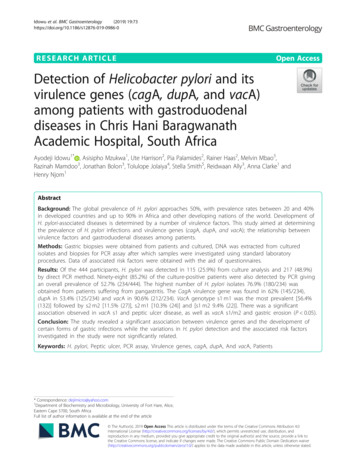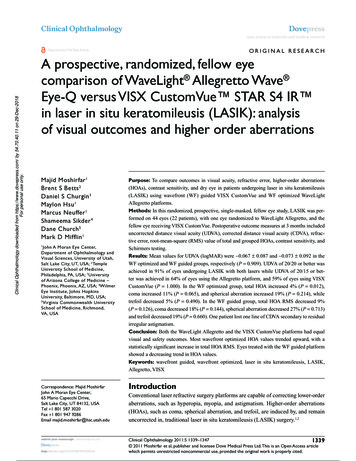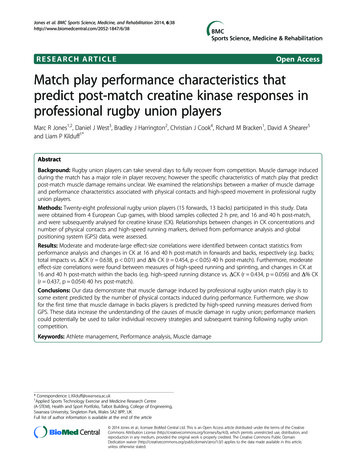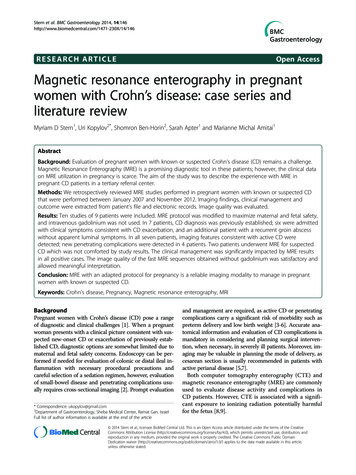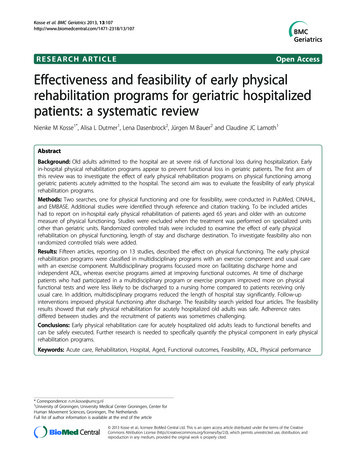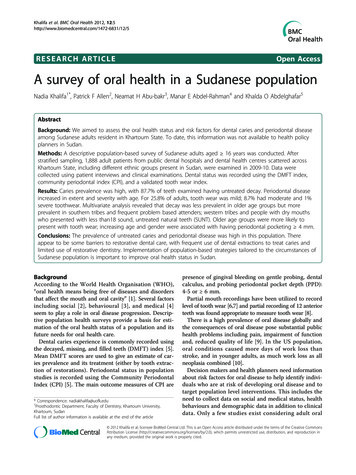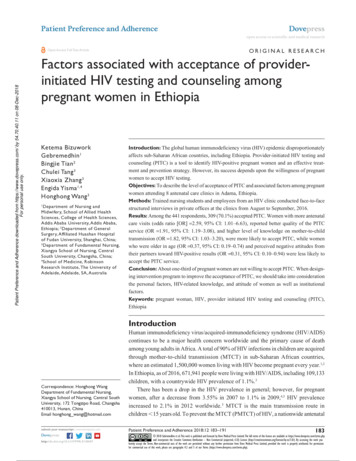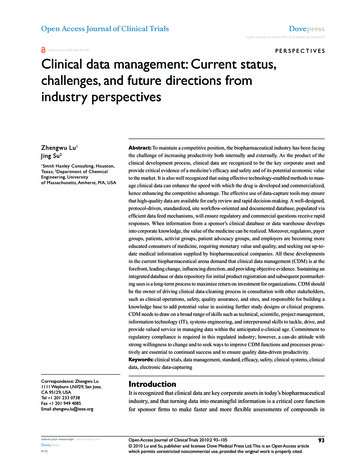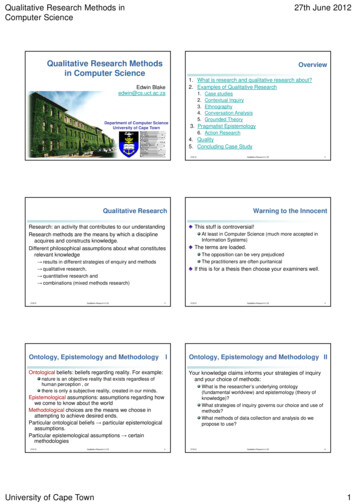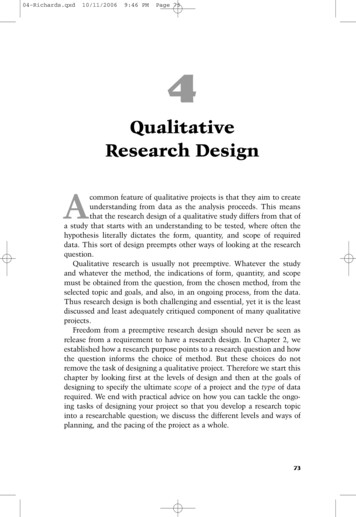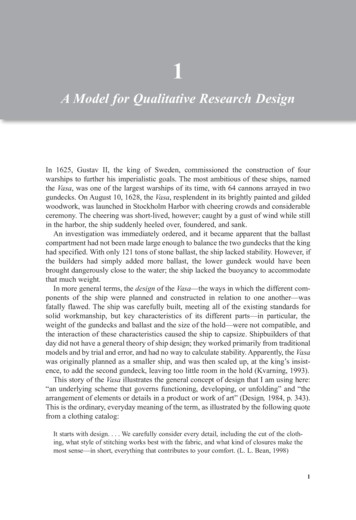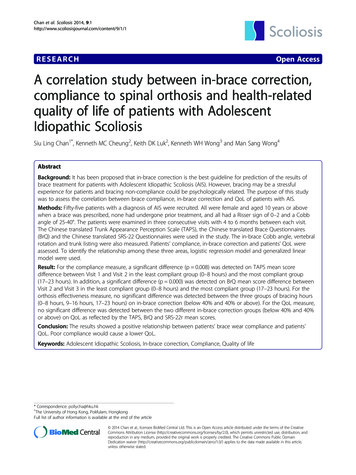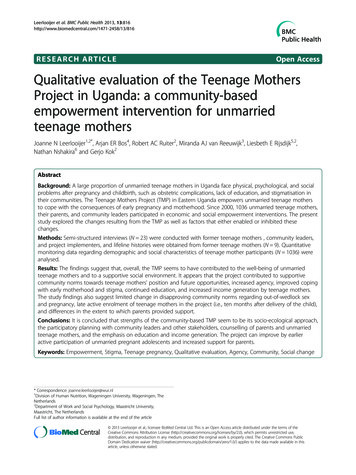
Transcription
Leerlooijer et al. BMC Public Health 2013, 6RESEARCH ARTICLEOpen AccessQualitative evaluation of the Teenage MothersProject in Uganda: a community-basedempowerment intervention for unmarriedteenage mothersJoanne N Leerlooijer1,2*, Arjan ER Bos4, Robert AC Ruiter2, Miranda AJ van Reeuwijk3, Liesbeth E Rijsdijk5,2,Nathan Nshakira6 and Gerjo Kok2AbstractBackground: A large proportion of unmarried teenage mothers in Uganda face physical, psychological, and socialproblems after pregnancy and childbirth, such as obstetric complications, lack of education, and stigmatisation intheir communities. The Teenage Mothers Project (TMP) in Eastern Uganda empowers unmarried teenage mothersto cope with the consequences of early pregnancy and motherhood. Since 2000, 1036 unmarried teenage mothers,their parents, and community leaders participated in economic and social empowerment interventions. The presentstudy explored the changes resulting from the TMP as well as factors that either enabled or inhibited thesechanges.Methods: Semi-structured interviews (N 23) were conducted with former teenage mothers , community leaders,and project implementers, and lifeline histories were obtained from former teenage mothers (N 9). Quantitativemonitoring data regarding demographic and social characteristics of teenage mother participants (N 1036) wereanalysed.Results: The findings suggest that, overall, the TMP seems to have contributed to the well-being of unmarriedteenage mothers and to a supportive social environment. It appears that the project contributed to supportivecommunity norms towards teenage mothers’ position and future opportunities, increased agency, improved copingwith early motherhood and stigma, continued education, and increased income generation by teenage mothers.The study findings also suggest limited change in disapproving community norms regarding out-of-wedlock sexand pregnancy, late active enrolment of teenage mothers in the project (i.e., ten months after delivery of the child),and differences in the extent to which parents provided support.Conclusions: It is concluded that strengths of the community-based TMP seem to be its socio-ecological approach,the participatory planning with community leaders and other stakeholders, counselling of parents and unmarriedteenage mothers, and the emphasis on education and income generation. The project can improve by earlieractive participation of unmarried pregnant adolescents and increased support for parents.Keywords: Empowerment, Stigma, Teenage pregnancy, Qualitative evaluation, Agency, Community, Social change* Correspondence: joanne.leerlooijer@wur.nl1Division of Human Nutrition, Wageningen University, Wageningen, TheNetherlands2Department of Work and Social Psychology, Maastricht University,Maastricht, The NetherlandsFull list of author information is available at the end of the article 2013 Leerlooijer et al.; licensee BioMed Central Ltd. This is an Open Access article distributed under the terms of theCreative Commons Attribution License (http://creativecommons.org/licenses/by/2.0), which permits unrestricted use,distribution, and reproduction in any medium, provided the original work is properly cited. The Creative Commons PublicDomain Dedication waiver ) applies to the data made available in thisarticle, unless otherwise stated.
Leerlooijer et al. BMC Public Health 2013, 6BackgroundEven though fertility rates among adolescents aged 15–19in sub-Saharan Africa have declined over the past decades,a large proportion of women delivers a child during adolescence [1]. Age of marriage has been increasing in mostcountries, whereas adolescents have remained sexuallyactive and few of them consistently use contraceptives.This has resulted in an increased prevalence of outof-wedlock pregnancies in adolescents [2]. Uganda is oneof the countries in sub-Saharan Africa with high rates ofteenage pregnancy: one out of four females aged 15–19gives birth to a child and the proportion of unplannedpregnancies has increased between 2001 and 2011 [3].Out-of-wedlock teenage pregnancy has major physical,social, and psychological consequences. In addition to theneed to cope with motherhood, many unmarried teenagemothers face stigma, lack of schooling, and livelihoodinsecurity [4-9]. The psychological and social consequences of out-of-wedlock motherhood can be addressedin interventions targeting teenage mothers combined withinterventions focusing on their social environment. Several studies and reviews suggest a comprehensive,community-based, and socio-ecological approach [4,9-13].A comprehensive, socio-ecological approach that focuses on relevant intrapersonal, interpersonal, community,organisational, national, and global levels of influence andinteraction, moves beyond change of individual behaviours. It recognises and addresses the structural contextswhich shape and limit people’s agency and therefore abilityto act [14,15]. In an empowerment approach, these socioecological levels of influence are incorporated, wherebyempowerment is a result of the interaction betweenindividual agency (i.e., the freedom to do whatever oneneeds to do to achieve goals or values that one views asimportant) and opportunity structure (i.e., the broader institutional, social, and political context of formal andinformal rules and norms within which actors pursue theirinterests) [16,17].Increasingly, evidence about socio-ecological interventions is generated by HIV prevention and care strategies [18,19], HIV-stigma reduction interventions [20,21],intimate-partner violence interventions [22,23], and genderand microfinance interventions [24]. However, there is aneed for empirical studies, to measure the effect of socioecological interventions in general [18,24] and of reproductive health interventions targeting unmarried teenagemothers in particular [13,25]. Evaluation of complex, socioecological interventions, presents a number of challenges,including restricted opportunities for randomisation, inadequate effect attribution to specific interventions, and limited control over implementation. Qualitative evaluationresearch can contribute to the identification of changes thatresult from specific intervention elements, which could befurther explored in quantitative impact evaluation [26].Page 2 of 15To contribute to the evidence-base of socio-ecologicalreproductive health interventions, we conducted a qualitative evaluation exploring the effects of a communitybased intervention in Eastern Uganda. The interventionunder study is the Teenage Mothers Project (TMP) thataims to create a supportive social environment and toaddress consequences of out-of-wedlock pregnancy andmotherhood among unmarried teenage mothers.The intervention: the Teenage Mothers ProjectThe TMP is implemented in the Manafwa district which ispopulated by the Bugisu tribe and situated on the Kenyanborder. The district, approximately 360,000 inhabitants,comprises 164 predominantly rural parishes. The TMPparticipants originate from 52 parishes in the district. Mostinhabitants are farmers and some are traders. Youngpeople are often unemployed or are engaged in temporaryor seasonal work in the informal economy. Socioeconomicstandards and literacy rates are generally low.The participatory project planning was guided by a planning group consisting of staff and volunteers of the community based organisation African Rural DevelopmentInitiatives (ARDI), a health promotion professional, andgovernmental, religious, and tribal leaders and unmarriedteenage mothers from the Manafwa district [27]. Theplanning group discussed suggestions of teenage mothersand community leaders to address certain needs, checkedthese with the health promotion professional, and implemented the selected interventions on a small scale. Ifmonitoring data showed acceptance by implementers andindicated change among beneficiaries, the activities wereimplemented on a larger scale. The project started in2000, based on the suggestion of unmarried teenagemothers to support them with a female goat that wouldsupply them with milk to support their child, with offspring that could be traded for a cow (approximately 25goats), and that would give them respect in their familyand community.The iterative project design was guided by the Intervention Mapping framework to ensure that the intervention was based on theory and evidence and tomaximise the likelihood of effectiveness [28]. Intervention Mapping is a stepwise planning framework anddescribes the iterative process of behaviour changeprogramme development from problem identificationto problem solving or mitigation. The first step was toconduct a needs assessment, revealing that out-ofwedlock teenage pregnancy, stigma, and violation of therights of unmarried mothers, and unawareness of itsmagnitude and consequences, were a major problem inthe communities in the Manafwa district [29]. It wasdecided to address the consequences of out-of-wedlockteenage pregnancies by intervening among various actors: the unmarried teenage mothers and their parents
Leerlooijer et al. BMC Public Health 2013, 6Page 3 of 15or guardians (referred to as parents in the remaining ofthis paper), school administrators, religious leaders, tribal leaders, governmental leaders on village, sub-county,district and national level, journalists, and the community at large. Even though the needs assessment showedthat many teenage mothers had to cope with the fatherof their child not taking responsibility, teenage motherswere hesitant to disclose the father’s name because theyfeared harassment or, in case of a loving relationship,feared that he would be accused of defilement. It wastherefore decided not to include the children’s fathersas target group in the TMP.The overall programme outcome was to improve thepsychological and social well-being of unmarried teenage mothers in the Manafwa district by increasing theirdecision making power (agency) and creating a supportive environment (opportunity structure). Behaviouraloutcomes for teenage mothers included effective copingwith stigma and with motherhood, continuation witheducation, income generation, having no or protectedsex, and advocacy for their rights. Coping was addressedthrough emotion-focused strategies (e.g., regulating negative emotions resulting from stigma or motherhood) andproblem-focused strategies (e.g., reconciliation withparents) [30,31]. Environmental outcomes included increased support for continued education and increasedcare for the unmarried teenage mother and her child byvarious environmental actors including parents and community leaders.To address the behavioural and environmental outcomes, five intervention components were developed:community sensitisation, teenage mothers support groups,livelihood (continued education and income generation),counselling, and advocacy. Behavioural and environmentalchange methods for these five components included participatory planning [32], modelling [33], mobilisation ofsocial networks [34], persuasive communication [35],entertainment education [36], advocacy [37], guided practice [38], provision of information about relevant others’approval [39], and social action [37]. See Bartholomewet al. [28] for an overview of behavioural and environmental change methods. The intervention was adoptedand implemented by trained community based volunteers, ARDI staff and community leaders. Table 1 provides an overview of the intervention components,beneficiaries, and deliverers of the TMP. The planningand a more elaborate description of the intervention aredescribed by Leerlooijer et al. [27].Table 1 Components, beneficiaries, and deliverers of the Teenage Mothers ProjectInterventioncomponentsDescription1. Communityawareness raisingAwareness raising during community meetings,including goats giving ceremonies in the parishof approximately 30 teenage mothers, attendedby community leaders and decision makers.BeneficiariesUnmarried teenagemothersEnvironmentalactorsn.a.Community membersNational and districtleadersARDI staffClan, religious, village,sub-county leadersClan, religious, village,sub-county leadersSchool administrators2. Teenage motherssupport groupA group consists of teenage mothers from aparticular parish in the project area. The groupsfocus on social support, advocacy, incomegeneration and sexual and reproductive healthand rights (SRHR) education.Unmarriedteenage mothersn.a.3. LivelihoodIncludes continued (formal) education of theteenage mothers and income generation inthe support groups and individually(i.e., goat rearing).Unmarriedteenage mothersSchool administratorsAimed at coping with stigma, reconciliation ofrelationships between parents and teenagemothers, and advice for continued education.Unmarriedteenage mothersParentsAims to change and/or implement policies andlegislation and to create more awareness anddiscussion about the well-being of unmarriedteenage mothers in Uganda.n.a.National, district, andcommunity leaders5. AdvocacyCommunity based volunteersParentsIntervention activities: speeches by influential(national) leaders, discussion about out-ofwedlock teenage pregnancy, testimonies ofteenage mothers and their parents, and songsand theatre plays (edutainment).4. CounsellingDeliverersCommunity based volunteersClan, religious, village,sub-county leadersCommunity based volunteersClan, religious, village,sub-county leadersARDI staff (counsellors)Community basedvolunteersARDI staffUnmarried teenagemothersJournalists
Leerlooijer et al. BMC Public Health 2013, 6Between March 2000 and March 2012, 1036 unmarried teenage mothers from 52 parishes in the Manafwadistrict had been participating in the TMP. Almost allteenage mothers in the project ar
Intervention activities: speeches by influential (national) leaders, discussion about out-of-wedlock teenage pregnancy, testimonies of teenage mothers and their parents, and songs and theatre plays (edutainment). School administrators 2. Teenage mothers support group A group consists of teenage mothers from a particular parish in the project .
